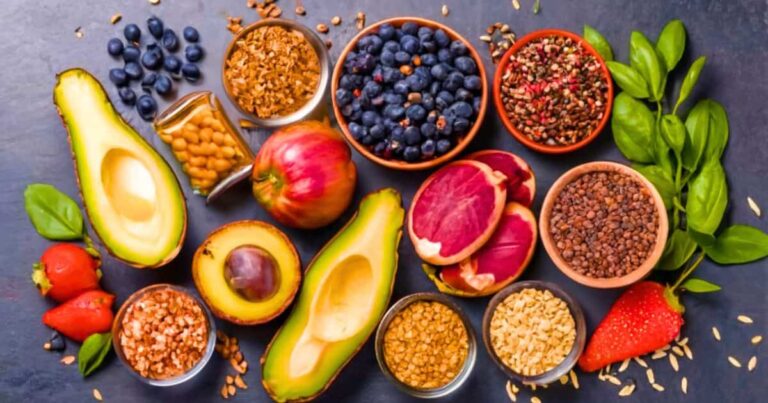Can a balanced diet really reduce the risk of chronic disease?
With the abundance of conflicting information on healthy eating, it’s challenging to make informed decisions about the food we eat. A well-balanced diet is crucial for maintaining overall health and well-being.
This comprehensive guide will explore the fundamental principles of healthy eating, providing evidence-based information on nutritional components that form the foundation of a balanced diet. By making informed choices about the foods we eat, we can significantly reduce the risk of chronic disease and improve our overall health.
Key Takeaways
- Understand the fundamental principles of a balanced diet
- Learn how to make informed choices about the food you eat
- Discover how small changes can reduce the risk of chronic disease
- Explore the importance of nutritional components in maintaining overall health
- Find out how to make healthy eating a sustainable part of your lifestyle
Why is Healthy Eating Important For Well-Being?
A nutritious diet is fundamental to maintaining good health and preventing disease. The food we eat provides our bodies with the necessary calories and nutrients to function properly. If our diet is deficient in certain nutrients or calories, our health may suffer.
Research has shown that diets rich in ultra-processed foods are linked to increased mortality and are associated with a greater risk of conditions like cancer and heart disease. On the other hand, diets comprising mostly whole nutrient-dense foods, such as the Mediterranean diet, are associated with increased longevity and disease protection.
The Connection Between Diet and Disease Prevention
A substantial body of scientific evidence links dietary patterns to major chronic diseases, including heart disease, type 2 diabetes, and certain cancers. Nutrient-dense foods provide essential compounds that support cellular function and protect against oxidative stress and inflammation, key drivers of disease development.
Studies have demonstrated how dietary choices directly impact biomarkers of health, including blood pressure, cholesterol levels, and inflammatory markers. For instance, a diet rich in fruits and vegetables has been shown to lower blood pressure and reduce the risk of heart disease.
You may like to read: Liver Cleanse 7 Days to Wellness
Benefits Beyond Disease Prevention: Energy, Mood, and Longevity
Proper nutrition affects not only disease prevention but also energy metabolism, cognitive function, and mood regulation through neurotransmitter production. Moreover, dietary patterns influence longevity and quality of life across different populations worldwide.
Research has shown that certain dietary patterns can influence the aging process and enhance the quality of life. For example, a study on the Mediterranean diet found that adherence to this diet was associated with a lower risk of age-related diseases.
| Dietary Pattern | Impact on Health | Key Components |
|---|---|---|
| Mediterranean Diet | Reduced risk of heart disease and certain cancers | High in fruits, vegetables, whole grains, and healthy fats |
| High in ultra-processed Foods | Increased risk of mortality and chronic diseases | High in processed meats, sugary drinks, and refined grains |
| Plant-based Diet | Improved overall health and reduced risk of chronic diseases | High in fruits, vegetables, legumes, and whole grains |
What Are The Good And Bad Dietary Fats?
Dietary fats are a crucial component of our diet, but their varied effects on health are often misunderstood. There are four main types of dietary fat, each with dramatically different effects on our health. Understanding these differences is essential for making informed dietary choices.
Trans Fats and Saturated Fats: What to Limit and Why
Trans fats, found in partially hydrogenated oils, are particularly harmful. They elevate harmful LDL cholesterol, reduce protective HDL cholesterol, and stimulate inflammation, damaging arteries and impairing cardiovascular health. Saturated fats, commonly found in red meat and dairy products, increase both harmful LDL and protective HDL cholesterol. While not as harmful as trans fats, saturated fats should still be consumed in moderation.
A comparison of these fats is shown in the table below:
| Fat Type | Effect on LDL | Effect on HDL | Health Impact |
|---|---|---|---|
| Trans Fats | Increases | Decreases | Damages cardiovascular health |
| Saturated Fats | Increases | Increases | Moderate consumption recommended |
Healthy Fats: Monounsaturated and Polyunsaturated Sources
Monounsaturated and polyunsaturated fats are essential for cardiac health. Monounsaturated fats, found in olive oil and avocados, have been shown to have cardiovascular benefits. Polyunsaturated fats, particularly omega-3 fatty acids found in fatty fish, are also crucial for heart health and have anti-inflammatory properties.

Practical Tips for Incorporating Healthy Fats
To incorporate healthy fats into your diet, consider the following tips: use olive oil for cooking, snack on nuts and seeds, include fatty fish in your meals at least twice a week, and add avocado to your salads. These simple changes can significantly improve your overall health and well-being.
By understanding the different types of dietary fats and making informed choices, you can improve your heart health and overall well-being.
You may like to read: Why Water Fasting Is Not Recommended by Doctors
Carbohydrates: Choosing Quality Over Quantity
The impact of carbohydrates on our health is a complex issue that depends largely on the type of carbohydrate consumed. Carbohydrates are a primary source of energy for the body, but the quality of these carbohydrates can significantly affect our overall health and well-being.
One of the key distinctions in carbohydrate quality lies in the difference between whole grains and refined grains. Understanding this difference is crucial for making informed dietary choices.
Whole Grains vs. Refined Grains: Understanding the Difference
Whole grains include the bran, germ, and endosperm of the grain, providing a rich source of fiber, vitamins, and minerals. In contrast, refined grains are processed to remove the bran and germ, leaving behind primarily empty calories. This processing strips away much of the nutritional value, including fiber and essential nutrients.
For example, consuming whole grains like brown rice or quinoa provides more nutritional benefits compared to refined grains like white rice or white bread. The processing of grains into refined products results in a loss of fiber and an increase in the glycemic index.
The Glycemic Index and Its Impact on Health
The glycemic index is a measure of how quickly a carbohydrate raises blood sugar levels. Foods with a high glycemic index, such as white bread or sugary snacks, cause a rapid spike in blood sugar, while foods with a low glycemic index, like whole grains or non-starchy vegetables, have a more gradual effect.
A diet high in foods with a high glycemic index can increase the risk of developing diabetes and cardiovascular disease. Therefore, choosing carbohydrates with a low glycemic index is beneficial for maintaining stable blood sugar levels and overall health.
Smart Carbohydrate Choices for Everyday Meals
Making smart choices about carbohydrates involves selecting whole, unprocessed foods like whole grains, fruits, and vegetables. These foods are rich in fiber and nutrients, providing sustained energy and supporting overall health.
For everyday meals, incorporating whole grains like whole wheat bread, brown rice, or quinoa is a good strategy. Additionally, a variety of colorful vegetables and fruits should be included to ensure a broad intake of essential nutrients and fiber.
Protein Power: Building Blocks for a Healthy Body
Our body relies heavily on protein to carry out various functions, from building and repairing tissues to producing enzymes and hormones. Protein is a fundamental component of our diet, essential for maintaining the overall health of our body.
Protein plays a crucial role in our bodily functions, acting as the building blocks for a healthy body. It is involved in tissue building and repair, enzyme production, immune function, and hormone synthesis. The metabolic systems engaged in protein production and repair can utilize amino acids from both animal and plant protein sources.
Pros and Cons of Animal and Plant Protein
When it comes to protein sources, there are two main categories: animal and plant-based. Animal protein sources, such as fish, poultry, eggs, and red meat, provide all essential amino acids, but they can be accompanied by other nutrients like fats that may have health implications. On the other hand, plant protein sources like legumes, nuts, seeds, and whole grains offer a different nutritional profile, often accompanied by beneficial fats and fiber.
Research from the Nurses’ Health Study indicates that consuming more protein from plant sources, such as beans, nuts, and seeds, while reducing easily digested carbohydrates, can lower the risk of heart disease. In contrast, increasing animal protein while cutting back on carbohydrates did not have the same effect, possibly due to the accompanying fats and other nutrients.
Optimal Protein Sources and Portions
Understanding the protein package concept is crucial, as it refers to the other nutrients that come with protein-rich foods. For instance, fish is a good source of protein and is also rich in omega-3 fatty acids, which are beneficial for heart health. When choosing protein sources, it is essential to consider the overall nutritional profile.
Here is a table showing some optimal protein sources and their nutritional profiles:
| Protein Source | Protein Content | Other Nutrients |
|---|---|---|
| Salmon fish | 20 grams per 3 oz serving | Rich in omega-3 fatty acids |
| Legumes lentils | 18 grams per 1 cup cooked | High in fiber, vitamins, and minerals |
| Poultry chicken | 26 grams per 3-oz serving | Good source of vitamins and minerals |
| Nuts and seeds, almonds | 6 grams per 1 oz serving | Rich in healthy fats and antioxidants |
When it comes to portion sizes, the recommended daily intake of protein varies based on factors such as age, activity level, and health status. Generally, the recommended dietary allowance is about 0.8 grams of protein per kilogram of body weight per day for adults. However, certain groups, such as athletes or those who are physically active, may require more protein.

The Ultimate Guide to Healthy Eating in Real Life: Fruits and Vegetables
Eating a variety of fruits and vegetables is a simple yet powerful way to enhance our well-being. These foods provide essential nutrients, including fiber, vitamins, and minerals, and numerous phytonutrients that are associated with protection against disease, such as cardiovascular disease, and maintenance of overall health.
Why Five Servings a Day Is Just the Minimum
Consuming fruits and vegetables in abundance is crucial, with a minimum of five servings a day recommended. Research indicates that as few as 1 in 4 persons in the United States meet this guideline. Increasing the daily intake of these foods can have significant health benefits. Eating more than five servings a day can further reduce the risk of various diseases and enhance overall well-being.
Creative Ways to Increase Your Intake
Increasing the daily consumption of vegetables and fruits can be achieved through meal planning, convenient preparation methods, and incorporating them into favorite dishes. For example, adding fruits to oatmeal or yogurt, or including vegetables in soups and stews, can be simple and effective ways to increase intake.%





